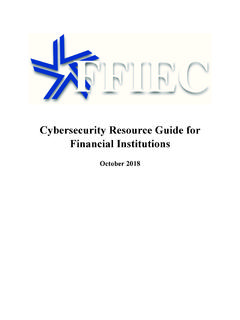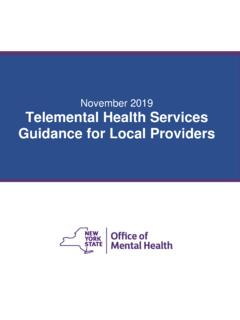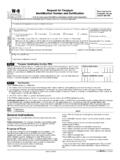Transcription of HAZARD MANAGEMENT POLICY & PROCEDURE - UCA SA
1 HAZARD MANAGEMENT POLICY & PROCEDURE Created Date: 01/07/2012 Version: 1 Reviewed Date: / / Page: 1 of 10 POLICY STATEMENT The Uniting Church SA ( UCSA ) is committed to providing a safe workplace for all personnel, contractors and visitors. UCSA is committed to establishing a formal process to record and investigate all workplace hazards . HAZARD MANAGEMENT is fundamental to ensuring a safe work environment, compliance with legislative requirements and for the continual improvement of OHS&W performance. This PROCEDURE defines the process to eliminate or control as far as reasonably practicable, all foreseeable hazards related to work activities or the workplace, to enable a safe working environment and safe systems of work.
2 DEFINITIONS - Please read over the definitions outlined in Appendix 1 RESPONSIBILITIES Managers/Church Council must establish and maintain a safe working environment and safe systems of work by: observing and identifying hazards ; investigating and responding to all HAZARD reports promptly; ensuring employees/volunteers etc. are notified of any hazardous situation and taking appropriate action to eliminate or control any risk associated with the HAZARD ; monitoring and reviewing effectiveness of controls; complying with legislative requirements; ensuring effective consultation takes place; maintaining appropriate documentation; providing information, instruction, training and supervision in order for work to be conducted in a safe manner; developing an effective workplace inspection process, specific to site/area and conduct inspections at a minimum of twice per year.
3 Refer to sample form Workplace Inspections Congregations (template) Personnel/Contractors/Visitors must: observing and identifying hazards ; report any HAZARD , incident or near miss to the manager or supervisor immediately and take reasonable steps to protect the health and safety of any person at risk; participate in the consultation process (Contractors and Visitors only where necessary); follow all reasonable instructions (eg. safe work PROCEDURE , safe practices, wearing protective equipment, undergoing training); take all reasonable care to protect their own health and safety and must take reasonable care to avoid adversely affecting the health or safety of any other person through an act or omission.
4 HAZARD MANAGEMENT POLICY & PROCEDURE VERSION 1 Page: 2 of 10 ACTIONS PROCEDURE HAZARD MANAGEMENT PROCESS (Steps 1 to 4) STEP 1 HAZARD Identification must be carried out: when planning work processes, work activities and events before purchase, hire, lease, commission/decommission, erection/dismantle of plant, equipment or substance prior to disposal or sale of plant, equipment or substances when changes are made to workplace, work activities or work methods anytime new information becomes available due to: - HAZARD reports - Workplace inspections - Legislative changes - Audit findings - Analysis of incident/accident/near miss occurrence - Testing results - Consultation with relevant parties Workplace Inspections (Minimum 2 per year) As Required due to Legislative changes, Publications, technological advances Audit Findings New and Modified equipment, plant and substances HAZARD Reports (observing & identifying) Workplace Changes environment work activity, methods Incident Reports (Accidents/Incidents/Near Misses) hazards Identified (All relevant information obtained) Assessment performed and suitable controls applied?
5 YES Go to Step 4 NO Go to Step 2 HAZARD MANAGEMENT POLICY & PROCEDURE VERSION 1 Page: 3 of 10 PROCEDURE STEP 2 Risk Assessment Gather as much information as possible about the HAZARD /s Choose the appropriate risk assessment tool (see below highlighted ones currently in development) Determine the level of risk by: a) Evaluating the likelihood or probability of harm occurring; and b) Estimating the severity of the potential consequences; applying the Risk Matrix below Choose the risk assessment tool that best relates to the level of risk associated with the HAZARD Keep in mind that the higher the risk and the more complex the activity or process, the more comprehensive the risk assessment needs to be.
6 RISK MATRIX Consequence (severity) 1 Insignificant 2 Minor 3 Moderate 4 Major 5 Catastrophic Trivial injury No treatment / in-house first aid Minor injury/illness/damage (<1 day off work) Significant injury/illness/damage (1-5 days off work) Extensive permanent injury/illness/damage (>5 days off work) Death/permanent disabling injury Likelihood 5 Almost certain to occur in most circumstances (daily-weekly) (5) Medium (10) High (15) Extreme (20) Extreme (25) Extreme 4 Likely to occur frequently (monthly) (4) Medium (8) High (12) High (16) Extreme (20) Extreme 3 Likely to occur at some time (yearly) (3) Low (6) Medium (9) High (12) High (15) Extreme 2 Unlikely to occur, but could happen (2 yearly) (2) Low (4) Low (6) Medium (8) High (10) High 1 May occur, but only in exceptional circumstances (every few years) (1) Low (2) Low (3) Low (4) Medium (5) Medium RISK RATING (from above)
7 Priority and Timeframe for Controls to be Assigned to the HAZARD Identified Extreme 15-25 Urgent/Critical Stop the job immediately and remedy before resuming work High 10-12 Remedy within 24 hours or cease task until interim Control measures are applied 8-9 Remedy within 3 days or cease task until interim Control measures are applied Medium 4-6 Remedy within 1 week or cease task until interim Control measures are applied Low 4 Remedy within 1 month 3 Remedy within 4 months 2 Re-assess within 6 months 1 Negligible Remedy if practicable and re-assess within 6 months GENERAL RISK ASSESSMENT (documented) TAKE 5 (verbal/consultative) for low risk-rated activities (see page 5) PLANT RISK ASSESSMENT (Form) Targeted Risk Assessment Tools MANUAL HANDLING RISK ASSESSMENT (Form) PRE-PURCHASE RISK ASSESSMENT (Form) HAZARDOUS SUBSTANCES RISK ASSESSMENT (Form) CONFINED SPACE RISK ASSESSMENT (Checklist) KEYBOARD WORKSTATION RISK ASSESSMENT (Checklist) VOICE STRAIN IDENTIFICATION (Checklist) HAZARD MANAGEMENT POLICY & PROCEDURE VERSION 1 Page: 4 of 10 PROCEDURE STEP 3 HAZARD Control Determine the most suitable control/s for managing the HAZARD and implement them before work begins.
8 * Prioritize: Extreme/high risk MUST take priority over low risk Use Hierarchy of Control from top down combining multiple controls, if needed to reduce the risk to as low as reasonably practicable ( ALARP ). Important Note: Any activity/task/process with a HAZARD result of Extreme , that cannot be reduced effectively, are not to be knowingly conducted or performed. H I E R AR C H Y O F C O N T R O L STEP 4 Documentation and review Develop and maintain a site HAZARD Register (see form) Review controls implemented Do the selected controls reduce the risk to an acceptable level? (check that controls are reasonably practicable and reduce the risks to ALARP) Monitor and review effectiveness of controls and document any additional hazards identified Update SOPs as required Revisit controls at intervals appropriate to the level of risk (minimum 5 years) and analyse all related information to determine if the controls continue to be appropriate and effective Retain all documents for a period of 5 years from the date of last entry Update site HAZARD Register (see form)
9 Remove eliminate the HAZARD Substitute replace with something less hazardous Engineering design the HAZARD out Administration adopt safe work practices, operating procedures , training, work organisation, signage, etc. Personal Protective Equipment (PPE) eg. safety footwear, masks, eye and hearing protection, high-visibility clothing, gloves, etc. HAZARD MANAGEMENT POLICY & PROCEDURE VERSION 1 Page: 5 of 10 PROCEDURE TAKE 5 RISK ASSESSMENT TOOL The TAKE 5 process is a 5 step mental process used to manage workplace hazards for LOW RISK RATED tasks or activities. 1. STOP AND LOOK Plan and take time to review the task with the work team and ask what could go wrong ? 2. THINK IT THROUGH and have a clear plan in mind Correct equipment and tools?
10 Enough people and time available? Is there a PROCEDURE for the task (SOP)? Am I/Are we competent to perform the task (induction/training)? Do I/we have all the information I need? Could other people or systems be affected? Is there a plan if something goes wrong/what is the plan if something goes wrong? Is there an alternative safer method? 3. IDENTIFY hazards what is the risk rating? (Low, Medium, High or Extreme) Look close: manual tasks, working at heights, splashes and sprays, isolation, vehicle movement, electrical hazards ? Look wide: conflicting tasks, escape routes, ignition sources, spills and leaks, people in area, suspended loads? Look for the hidden: electricity, stored energy, thermal hot and cold, compressed air or liquids?



